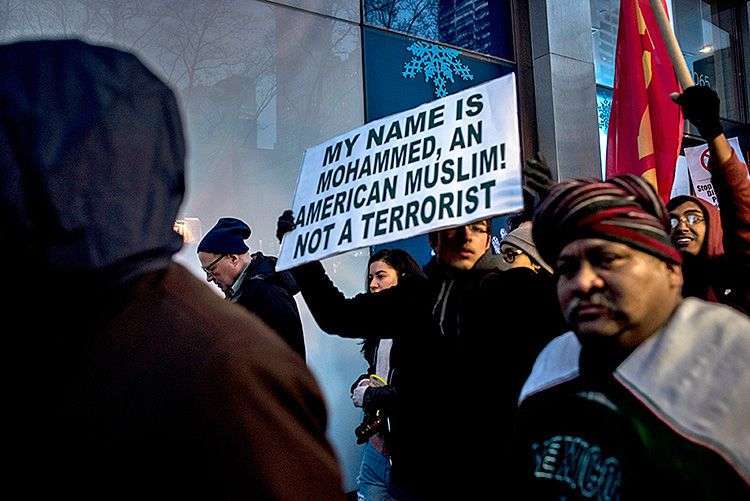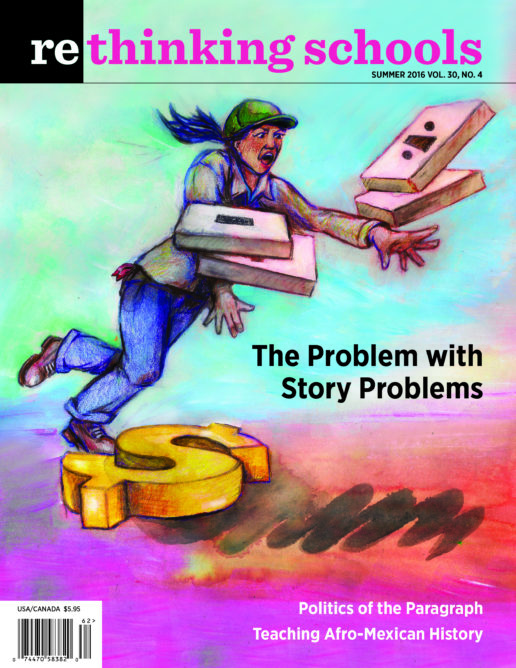Short Stuff 30.4
Illustrator: Nina Berman / NOOR

Nina Berman / NOOR
FBI Tells Schools to Spy on Students
A new initiative of the FBI’s Combating Violent Extremism (CVE) program urges high schools to report students who criticize government policies as potential future terrorists, warning that “anarchist extremists” are in the same category as ISIS, and that young people who are poor, immigrants, or travel to “suspicious” countries are more likely to commit violence.
The “Preventing Violent Extremism in Schools” guidelines (info.publicintelligence.net/FBI-PreventingExtremismSchools.pdf) identify risk factors that are so broad that virtually any young person could be deemed dangerous and worthy of surveillance, especially if they are politically outspoken or come from a poor or immigrant family. According to the FBI criteria, children who exhibit “development delays or disorders, resulting from low-quality supportive environments” are at greater risk. So are the “disenfranchised—students feeling lost, lonely, hopeless, or abandoned.” The FBI calls for greater scrutiny of students with mental health disorders and identifies neighborhoods, families, and socio-economic status as factors to watch out for.
The new guidelines depict high schools as hotbeds of extremism: “High school students are ideal targets for recruitment by violent extremists seeking support for their radical ideologies, foreign fighter networks, or conducting acts of violence within our borders.” In addition to watching for “signs of extremist thought” among their students, the FBI suggests that teachers “incorporate a two-hour block of violent extremism awareness training” into the core curriculum for all youth in grades 9-12.
As curriculum for that training, the FBI released an interactive website for youth: “Don’t Be a Puppet: Pull Back the Curtain on Violent Extremism” (cve.fbi.gov/home.html). The website includes a series of learning modules with quizzes at the end. According to the website, the following offenses constitute signs that “could mean that someone plans to commit violence” and therefore should be reported: “talking about traveling to places that sound suspicious,” “using code words or unusual language,” “using several different cell phones and private messaging apps,” and “studying or taking pictures of potential targets (like a government building).”
In the “Known Violent Extremists” module, the category of domestic terrorists includes “anarchist extremists” and “animal rights extremists and environmental extremists” alongside “white supremacy extremists,” ISIS, and Al Qaeda as terrorists out to recruit high school students. The materials instruct students to watch out for extremist propaganda messages that communicate criticisms of “corrupt Western nations” and express “government mistrust.” If you “see suspicious behavior that might lead to violent extremism,” the resource states, consider reporting it to “someone you trust,” including local law enforcement officials like police officers and FBI agents.
At the surface level, the FBI’s new guidelines do not single out Muslim students. The guidelines and supplementary educational materials warn of a broad array of threats, including anti-abortion and white supremacist extremists. The Jewish Defense League is listed alongside Hezbollah and Al Qaeda as an imminent danger to young people in the United States.
But a closer read reveals that the FBI consistently invokes an Islamic threat without naming it. Cultural and religious differences, as well as criticisms of Western imperialism, are repeatedly mentioned as risk factors. “Some immigrant families may not be sufficiently present in a youth’s life due to work constraints to foster critical thinking,” the guidelines state.
According to Arun Kundnani, author of The Muslims Are Coming! Islamophobia, Extremism, and the Domestic War on Terror and an adjunct professor at New York University: “Drawing on the junk science of radicalization models, the document dangerously blurs the distinction between legitimate ideological expression and violent criminal actions. In practice, schools seeking to implement this document will end up monitoring Muslim students disproportionately. Muslims who access religious or political material will be seen as suspicious, even though there is no reason to think such material indicates a likelihood of terrorism.”
In 2015, then-Attorney General Eric Holder unveiled CVE pilot programs in Boston, Minneapolis, and Los Angeles. According to the Council on American-Islamic Relations, these initiatives solely target Muslims. Nearly 50 Muslim organizations in the Minneapolis area issued a statement that concluded: “It is our recommendation that the government stop investing in programs that will only stigmatize, divide, and marginalize our communities further.” Instead, the government is expanding CVE programming into high schools across the country.
According to Hugh Handeyside, staff attorney for the ACLU’s national security project, “Framing this conduct as ‘concerning behavior’ doesn’t conceal the fact that the FBI is policing students’ thoughts and trying to predict the future based on those thoughts.”
Excerpted from an article by Sarah Lazare for AlterNet, March 2, 2016. Access the complete article at alternet.org.
Election Rhetoric Harms Students
According to The Trump Effect: The Impact of the Presidential Campaign on Our Schools, Maureen B. Costello’s recent report for the Southern Poverty Law Center (SPLC), “The campaign is having a profoundly negative effect on children and classrooms. It’s producing an alarming level of fear and anxiety among children of color and inflaming racial and ethnic tensions in the classroom. . . . Teachers have noted an increase in bullying, harassment, and intimidation of students whose races, religions, or nationalities have been the verbal targets of candidates on the campaign trail.”
SPLC surveyed 2,000 K-12 teachers who subscribe to Teaching Tolerance or use the website so, as they point out, this was not a scientific survey. But the results are significant nonetheless:
- More than two-thirds of the teachers reported that students—mainly immigrants, children of immigrants, and Muslims—have expressed concerns or fears about what might happen to them or their families after the election.
- More than half the teachers have seen an increase in uncivil political discourse.
- More than one-third have observed an increase in anti-Muslim or anti-immigrant sentiment.
- More than 40 percent are hesitant to teach about the election.
One teacher from a middle school with a large population of African American Muslims wrote: “My students are terrified of Donald Trump. They think that if he’s elected, all Black people will get sent back to Africa.”
A kindergarten teacher reported that a Latino child—told by classmates that he will be deported and trapped behind a wall—asks every day, “Is the wall here yet?”
Another teacher wrote: “I try to not bring it up since it is so stressful for my students.”
This teacher’s reluctance is understandable, but opening up supportive discussions in classrooms about critical thinking, Islamophobia, and racism—in addition to poverty, climate change, the housing crisis, international trade, immigration, and other election topics—is more crucial than ever.

